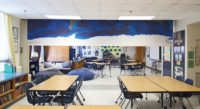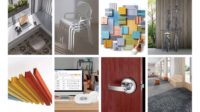 |
| Photo © Darris Lee Harris |
| At the William P. Gray School in Chicago, the first school to implement the Learning Module furniture system, the units feature a combination of open storage cubbies, cabinet doors, sliding whiteboards, and power/ data poles, and partitions off the various learning zones. |
When a progressive middle school program called Teach to One: Math launched in 201 it challenged a group of architects and designers not only to rethink the learning environment, but to develop a furniture system capable of supporting its education model. Devised by the nonprofit organization New Classrooms, the program proposes more effective instruction through a range of experiences within a single room: interactive group activities, peer-to-peer learning, independent study on computers or through printed lessons, and traditional live teacher instruction. With guidance from the American Architectural Foundation (AAF) and funding from the Target retail corporation, the team produced a design guide with floor plans and suggested furnishings, including a new core multifunctional furniture piece—the Learning Module.
Now available in conjunction with the program, the Module is a made-to-order birch plywood shelving system that doubles as a space divider, and each can be specified with varied open-cubby and door configurations in different widths and heights. “The furniture shapes the spaces, helping students focus but still maintaining sight lines for teachers,” says Caroline Otto, a senior associate of Anderson Architects. Otto collaborated on both space and furniture development, along with Scott Lauer, an independent architect formerly with the AAF, and Jonas Milder, principal of furniture design company Milder Office and himself a teacher.
The system was designed to be flexible and easy to install without compromising stability and durability. Mounted to the floor, the units have fixed and removable shelves to meet changing storage needs for printed or object-based lesson materials, or to create more openness or a lower partition. Because the Learning Module defines space, schools implementing the program can quickly readjust their Teach to One: Math centers during the summer before the school year begins again, without the cost and complication of renovating a space.
The integrated solutions of the system eliminate the need for extraneous fixtures: the Modules can support the monitors that direct students to their assigned areas; poles can be inserted to provide power and data access points for computer equipment; and tracks can be installed for sliding whiteboards and interactive boards. Otto sums up, “Existing furniture pieces could do one or two functions, but not the six, seven, or eight that our pieces are actually doing.”
newclassrooms.org circle 213
newclassrooms.org circle 213



